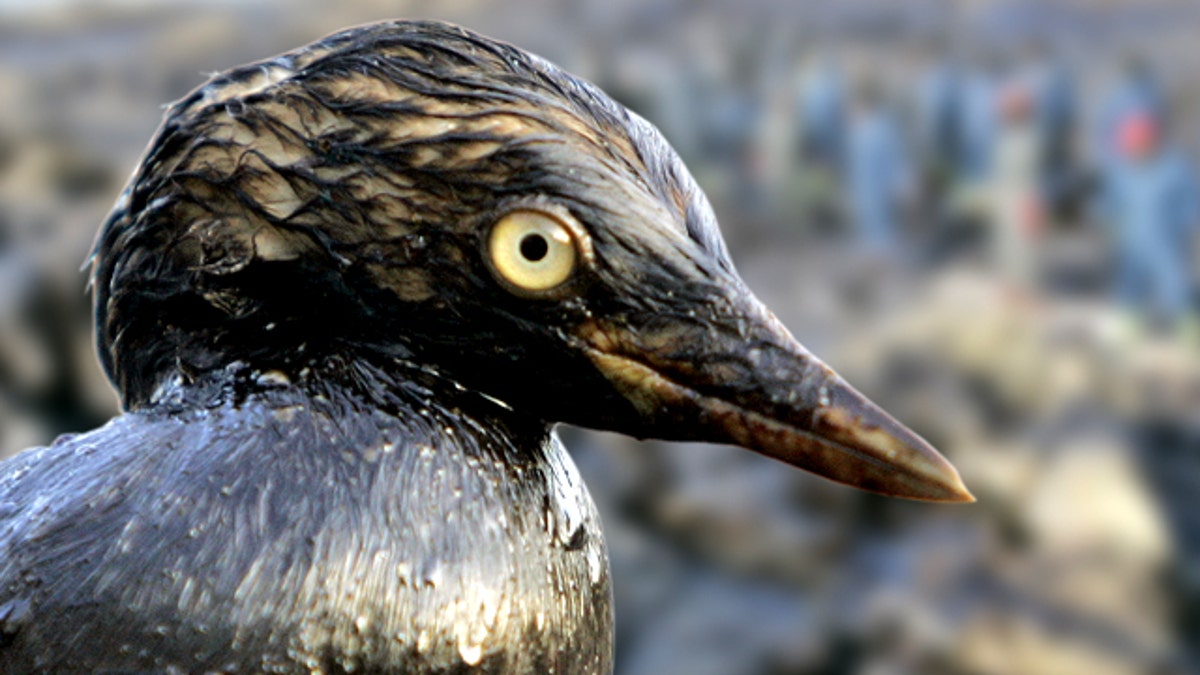
A migratory bird, covered with crude oil, found by an environmental activist at Shinduri beach in Taean, west of Seoul, South Korea, in 2007. (AP Photo/Lee Jin-man)
A giant oil slick from last week's deadly offshore drilling rig explosion in the Gulf of Mexico threatens wide-scale coastal damage for four states -- and could be a disaster for wildlife.
The biggest concern over the effect the spill could have on fauna would be its effect on coastal wildlife. In a press conference Thursday, the EPA announced that the oil slick could reach shore Friday afternoon. And when it does, the oil will float and adhere to everything it comes in contact with, living or otherwise.
"The challenge with this type of oil is it's going to float, and depending on what the wind and waves do it may stick around for a while," said Tom Brosnan of NOAA's Assessment and Restoration Division. "And as you get closer to the shorelines you tend to find richer life," he observed.
Here are some possible impacts from the massive oil spill on the wildlife in the Gulf environment.
BIRDLIFE
Several areas that are important to bird populations could be potentially affected.
According to the National Audubon Society, places it has designated as "Important Bird Areas" could be threatened by the slick, including Chandeleur Islands and Gulf Islands National Seashore in Louisiana and Mississippi. Other nearby IBAs could be at risk as well, notably the Delta National Wildlife Refuge and Pass-a-Loutre Wildlife Management Area in Louisiana.
Species at risk include Louisiana's state bird, the brown pelican, which was only removed from the U.S. Endangered Species list last year. The pelicans nest on barrier islands and feed near shore, and their breeding season has just started.
When coated in oil, birds' feathers lose their ability to trap air and repel water, reported LiveScience. The result: Birds can't hold in heat and become hypothermic, according to the Oiled Wildlife Care Network. To keep warm, an oil-coated bird will increase its metabolism, which requires energy; this means the bird will have a greater need for food.
Unfortunately, the sticky feathers can disrupt the bird's buoyancy so it doesn't float as well, making it tricky for the bird to snag much-needed food. Other species that would not fare well, especially if the slick comes ashore, include the American oystercatcher and Wilson's plover.
FISH
The northern Gulf of Mexico is a crucial spawning ground at this time of the year for the Atlantic population of bluefin tuna, which is critically endangered. Their eggs float near the surface and the larvae also stay there after they first hatch. So the spill has occurred at a critical time in their life-cycle.
"We expect a spill like this could dramatically decrease the amount of bluefin tuna larvae that are surviving," said John Hocevar, the Oceans Campaign director for Greenpeace USA.
The Gulf menhaden fishery -- a species harvested mostly for fish meal and fish oil -- is America's third largest and in some seasons its second largest, according to Greenpeace. Menhaden are filter feeders and so they could be badly affected by the spill, as they pass tainted water through their filtering system.
Losses could also be inflicted on the shrimp and oyster industries in Louisiana. Oysters are filter feeders and cannot swim to escape the slick. The prime oyster-gathering season in Louisiana starts on May 1.
OTHERS
Coastal species aren't the only wildlife potentially threatened by the spill. Many animals could come into contact with the oil slick as it moves out in the open ocean, Brosnan told LiveScience. He noted fin whales, sperm whales and bottlenose dolphins among the sea creatures that could be at risk.
And several species of sea turtles are currently moving through the Gulf, as their spring nesting seasons commences and they need to surface to breathe, so the slick at the water's top could damage their populations.
LiveScience and Reuters contributed to this report.




















